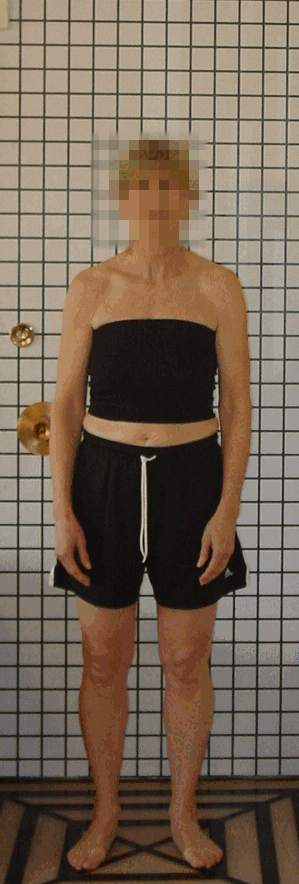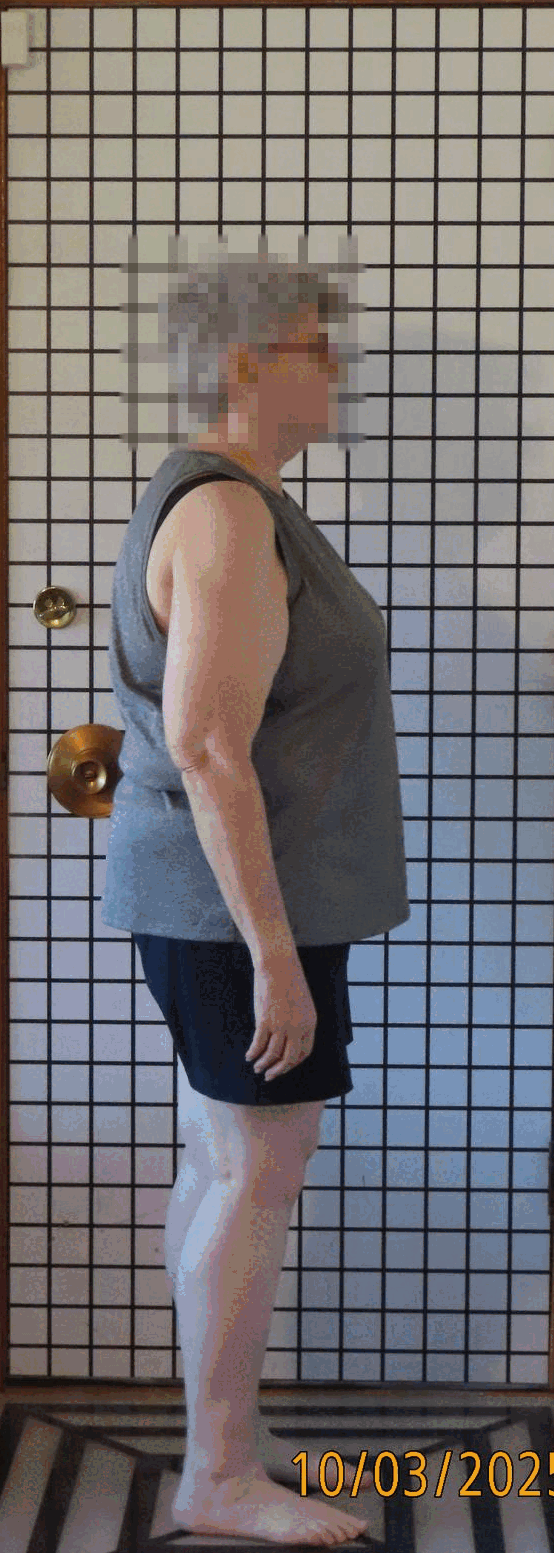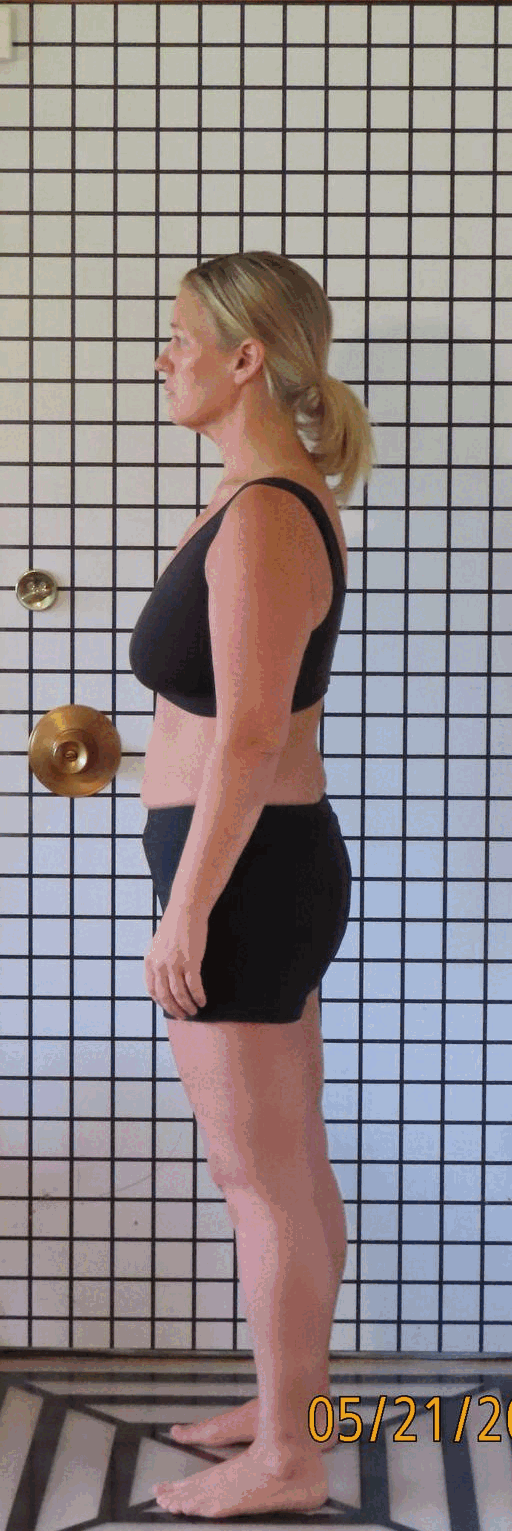Blog
Nuanced Shifts in Body Alignment
 In this image a small adjustment in my client’s body can create a ripple effect, impacting their entire structure. In this example, when my client's left leg rotates laterally, it allows her entire left side of her body to lengthen. This subtle change results in greater evenness in both her hips and her shoulder girdles. These gentle shifts, although seemingly minor, can lead to significant changes in overall body alignment. By fostering these nuanced adjustments, our goal is to help clients connect with their bodies in a meaningful way. This connection empowers them to experience improved fluidity and efficiency of movement, while also reducing areas of pain and restriction.
In this image a small adjustment in my client’s body can create a ripple effect, impacting their entire structure. In this example, when my client's left leg rotates laterally, it allows her entire left side of her body to lengthen. This subtle change results in greater evenness in both her hips and her shoulder girdles. These gentle shifts, although seemingly minor, can lead to significant changes in overall body alignment. By fostering these nuanced adjustments, our goal is to help clients connect with their bodies in a meaningful way. This connection empowers them to experience improved fluidity and efficiency of movement, while also reducing areas of pain and restriction.
Full Body Connection
 During this session, my client demonstrated significant shifts from feet to head, beginning with his feet and their reorientation to a more parallel alignment. This adjustment facilitated the gastrocnemius muscle compartments to shift appropriately toward the posterior aspect of both lower legs, promoting optimal positioning of the hips in a more horizontal presentation—a key element in the Rolfing process. Additionally, the client's torso elongated, contributing to increased height, and his head rotated centrally over his body.
During this session, my client demonstrated significant shifts from feet to head, beginning with his feet and their reorientation to a more parallel alignment. This adjustment facilitated the gastrocnemius muscle compartments to shift appropriately toward the posterior aspect of both lower legs, promoting optimal positioning of the hips in a more horizontal presentation—a key element in the Rolfing process. Additionally, the client's torso elongated, contributing to increased height, and his head rotated centrally over his body.
Empowering your journey through Rolfing
 Reducing the flexion in my client’s thighs is aiding her progression toward a more upright posture. Our next focus will be above the pelvis. Although not clearly visible in the photo, there's a subtle rotational adjustment in her pelvis that results in a more balanced appearance in that region. When working with clients, our goal is to establish a lateral alignment within the gravitational field, which leads to more efficient movement, improved fluidity, a wider range of motion, and importantly, the relief from persistent pain in areas such as the back, neck, shoulders, hips, and feet that brings many people to Rolfing.
Reducing the flexion in my client’s thighs is aiding her progression toward a more upright posture. Our next focus will be above the pelvis. Although not clearly visible in the photo, there's a subtle rotational adjustment in her pelvis that results in a more balanced appearance in that region. When working with clients, our goal is to establish a lateral alignment within the gravitational field, which leads to more efficient movement, improved fluidity, a wider range of motion, and importantly, the relief from persistent pain in areas such as the back, neck, shoulders, hips, and feet that brings many people to Rolfing.
Rolfing: Its not what you think-it's what you feel!
 During this session, my client demonstrated progress toward integration both above and below the pelvic region. There is pronation in both her left and right foot and after the session she moves toward a more parallel orientation with more support as her legs are better positioned under her pelvis. Her weight-bearing shifts from left to right, while relaxation of the anterior shoulder girdles facilitate greater lateral movement of the arms away from a forward position. My client's head became more centered over her shoulders, contributing positively to the overall integration process. Through Rolfing we get people to move with more ease with better alignment and feel better in their body through the process.
During this session, my client demonstrated progress toward integration both above and below the pelvic region. There is pronation in both her left and right foot and after the session she moves toward a more parallel orientation with more support as her legs are better positioned under her pelvis. Her weight-bearing shifts from left to right, while relaxation of the anterior shoulder girdles facilitate greater lateral movement of the arms away from a forward position. My client's head became more centered over her shoulders, contributing positively to the overall integration process. Through Rolfing we get people to move with more ease with better alignment and feel better in their body through the process.
Warning: Transformation May Cause Dramatic Shifts!
 Over the past several months, I have been working with my client to develop an improved and more efficient gait pattern, following her history of a fractured ankle and subsequent plate implantation eight years ago. As her right leg has become increasingly comfortable with weight bearing, she has reported greater ease in walking and an enhanced willingness to explore movement strategies that promote optimal gait mechanics. The increased ability to bear weight on her right leg is also positively influencing the alignment and structure above her pelvis, resulting in improved lift throughout the anterior and posterior aspects of her body as well as a more balanced lateral line. This progress toward structural balance is being addressed through the Rolfing process, working within the constraints of her previous injury.
Over the past several months, I have been working with my client to develop an improved and more efficient gait pattern, following her history of a fractured ankle and subsequent plate implantation eight years ago. As her right leg has become increasingly comfortable with weight bearing, she has reported greater ease in walking and an enhanced willingness to explore movement strategies that promote optimal gait mechanics. The increased ability to bear weight on her right leg is also positively influencing the alignment and structure above her pelvis, resulting in improved lift throughout the anterior and posterior aspects of her body as well as a more balanced lateral line. This progress toward structural balance is being addressed through the Rolfing process, working within the constraints of her previous injury.
Helping you Realign with Gravity

In this week’s blog I worked with another client to realign her body toward the Rolfing line. Her thighs showed less flexion, her shoulders were less rounded, and her head sat more naturally above her shoulder girdle. By encouraging her body to organize around a central vertical axis, we made noticeable strides in this session. Our aim is to help each person discover their own inherent balance centered on the concept of "the line." This holistic approach promotes better posture, increased balance, and smoother movement. As Dr. Rolf famously stated, “gravity is the therapist.”
Feeling Better through Rolfing
 Continuing the discussion from last week’s blog on the Rolfing line, we examine another client case. This example demonstrates decreased thigh flexion and a shift toward a more natural anterior pelvic tilt, resulting in an improved lateral line and enhanced structural stability. These changes contribute to a slight increase in height and overall better alignment. At Rolfing Iowa, we are committed to helping clients achieve improved movement, appearance, and well-being.
Continuing the discussion from last week’s blog on the Rolfing line, we examine another client case. This example demonstrates decreased thigh flexion and a shift toward a more natural anterior pelvic tilt, resulting in an improved lateral line and enhanced structural stability. These changes contribute to a slight increase in height and overall better alignment. At Rolfing Iowa, we are committed to helping clients achieve improved movement, appearance, and well-being.
The Rolfing Line
 During this session, my client demonstrated notable improvement while moving toward a Rolfing “line” which creates a more effortless upright posture with greater overall stability. There was decreased thigh flexion, a more natural anterior pelvic tilt, reduced rounding of the shoulder girdle, and diminished forward head posture, resulting in an overall substantial shift reflecting elements of the “line” approach. It is important to note that not all clients will exhibit such easily visible changes; however, even in these cases, individuals can perceive meaningful differences in their bodies and experience enhanced fluidity of movement.
During this session, my client demonstrated notable improvement while moving toward a Rolfing “line” which creates a more effortless upright posture with greater overall stability. There was decreased thigh flexion, a more natural anterior pelvic tilt, reduced rounding of the shoulder girdle, and diminished forward head posture, resulting in an overall substantial shift reflecting elements of the “line” approach. It is important to note that not all clients will exhibit such easily visible changes; however, even in these cases, individuals can perceive meaningful differences in their bodies and experience enhanced fluidity of movement.
Working with Octogenarians
 Individuals seek Rolfing for a variety of purposes, including enhancing their mobility. For many octogenarians, the primary motivation might be to maintain balance and reduce the risk of unexpected falls, which can often initiate a series of complications leading to decreased mobility and diminished quality of life. In this session my client shifts dramatically toward a better-balanced structure. Movement is from left to right, with a more horizontal pelvis, which is one of the hallmarks in the Rolfing process, and there is more equal weight distribution through both legs, Rolfing can help clients regain confidence in their movement patterns and foster a greater sense of independence. If you have relatives in this age group, consider referring them to Rolfing Iowa to support their stability.
Individuals seek Rolfing for a variety of purposes, including enhancing their mobility. For many octogenarians, the primary motivation might be to maintain balance and reduce the risk of unexpected falls, which can often initiate a series of complications leading to decreased mobility and diminished quality of life. In this session my client shifts dramatically toward a better-balanced structure. Movement is from left to right, with a more horizontal pelvis, which is one of the hallmarks in the Rolfing process, and there is more equal weight distribution through both legs, Rolfing can help clients regain confidence in their movement patterns and foster a greater sense of independence. If you have relatives in this age group, consider referring them to Rolfing Iowa to support their stability.
Impressive First Session Shift
 During my client's initial session at Rolfing Iowa, there was notable improvement in vertical alignment. Her head was better positioned above her shoulder girdles, with reduced shoulder rounding and enhanced lift in the pelvic girdle. This bodywork modality is a process-oriented re-education of the body through movement and touch, and it systematically releases patterns of stress and impaired function. Individuals of varying backgrounds and ages seek Rolfing Structural Integration not only for pain and stress relief, but also to optimize their performance and enhance mobility in everyday activities.
During my client's initial session at Rolfing Iowa, there was notable improvement in vertical alignment. Her head was better positioned above her shoulder girdles, with reduced shoulder rounding and enhanced lift in the pelvic girdle. This bodywork modality is a process-oriented re-education of the body through movement and touch, and it systematically releases patterns of stress and impaired function. Individuals of varying backgrounds and ages seek Rolfing Structural Integration not only for pain and stress relief, but also to optimize their performance and enhance mobility in everyday activities.



